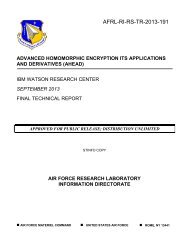EN100-web
EN100-web
EN100-web
You also want an ePaper? Increase the reach of your titles
YUMPU automatically turns print PDFs into web optimized ePapers that Google loves.
Research and Innovation<br />
Combinatorial Problem<br />
Solving for fair Play<br />
by Mats Carlsson<br />
To create a fair timetable for the men's handball league<br />
is a much more complex task than you would think.<br />
There are actually many more ways to do it than there<br />
are atoms in the universe, and only one of them is<br />
perfect. The trick is to find it!<br />
The top Swedish men's handball league, Elitserien, consists<br />
of two divisions of seven teams each. Every season, a<br />
timetable for 33 periods needs to be constructed. In the first<br />
seven periods, two parallel tournaments are played with<br />
every team meeting every other team from the same division.<br />
In the next 13 periods, one league-level tournament is played<br />
with every team meeting every other team. In the last 13<br />
periods, the league-level tournament is played again, in<br />
reverse order.<br />
The timetable must satisfy a number of other rules, such as:<br />
• If team A plays team B at home, then team B must play<br />
team A at home the next time they meet.<br />
• Teams can play at home at most twice in a row and away<br />
at most twice in a row, and such cases should be minimized.<br />
• Both divisions must have three pairs of complementary<br />
schedules.<br />
• Specific high-profile matches between given teams should<br />
be scheduled in specific periods.<br />
• Some teams can't play at home during specific periods,<br />
because the venue is unavailable.<br />
Visually, you can think of it as a matrix with 280 cells, each<br />
filled with a number between 1 and 27. There are more than<br />
10 400 ways to do the task, or commonly expressed 1 followed<br />
by 400 zeroes. As a comparison there are only about 10 80<br />
atoms in the universe. Out of the vanishingly small amount<br />
of correctly filled matrices that you will find, there is one<br />
optimal solution. The trick is to find it.<br />
Traditionally, the time-tabling has been carried out manually<br />
by the Swedish Handball Federation. The problem is too difficult<br />
for a human to solve to optimality, and so the<br />
Federation has always had to compromise and break some<br />
rules in order to come up with an acceptable timetable. The<br />
method from SICS solves it without breaking any rules.<br />
Researchers at KTH, the Royal Institute of Technology, had a<br />
first attempt at the problem. They conducted an initial formal<br />
study of the Elitserien schedule problem, and discovered<br />
some important structural properties. SICS continued the<br />
study, formally modelled the problem using Constraint<br />
Programming, and was thereby able to solve it to optimality<br />
in about five CPU seconds.<br />
They first defined the variables to be used in the CP set-up,<br />
and then the essential constraints to ensure the resultant<br />
schedule will satisfy Elitserien’s structural requirements.<br />
Next they highlighted some implied constraints and symmetry<br />
breaking properties that they found would greatly<br />
reduce the search effort. Finally, they modelled the league’s<br />
seasonal constraints so they could construct the entire<br />
schedule in an integrated approach. The constraint model<br />
was encoded in MiniZinc 1.6 and executed with Gecode<br />
3.7.0 as back-end.<br />
This timetabling problem is a typical combinatorial problem.<br />
Constraint programming has been used for sports scheduling<br />
before. However, case studies solved by integrated CP<br />
approaches are scarce in the literature. Perhaps the problems<br />
have been assumed to be intractable without decomposition<br />
into simpler sub-problems.<br />
References:<br />
[1] J Larson, M Johansson, M Carlsson: “An Integrated<br />
Constraint Programming Approach to Scheduling Sports<br />
Leagues with Divisional and Round-Robin Tournaments”,<br />
CPAIOR, LNCS 8451, pp. 144-158, Springer, 2014<br />
[2] J. Larson, M. Johansson: “Constructing schedules for<br />
sports leagues with divisional and round-robin tournaments”,<br />
Journal of Quantitative Analysis in Sports (2014),<br />
DOI:10.1515/jqas-2013-0090<br />
Please contact:<br />
Mats Carlsson, SICS Swedish ICT, Sweden<br />
E-mail: matsc@sics.se<br />
PHoto: Shutterstock<br />
48<br />
ERCIM NEWS 100 January 2015



